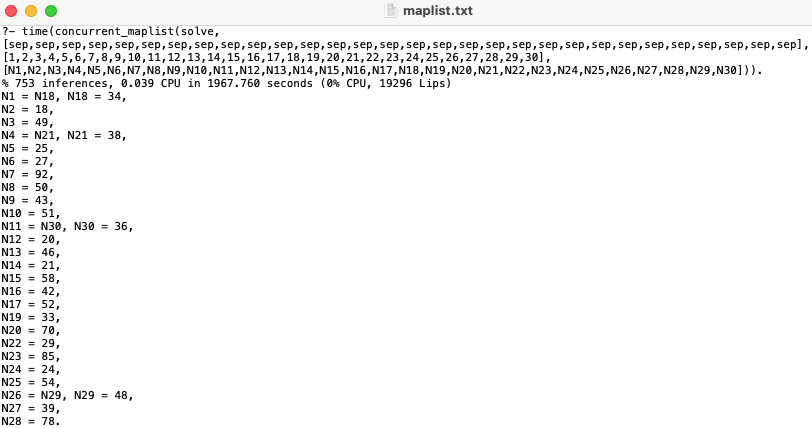
Goal: arrange the pieces to cover everything except the month and day for each day of the year.
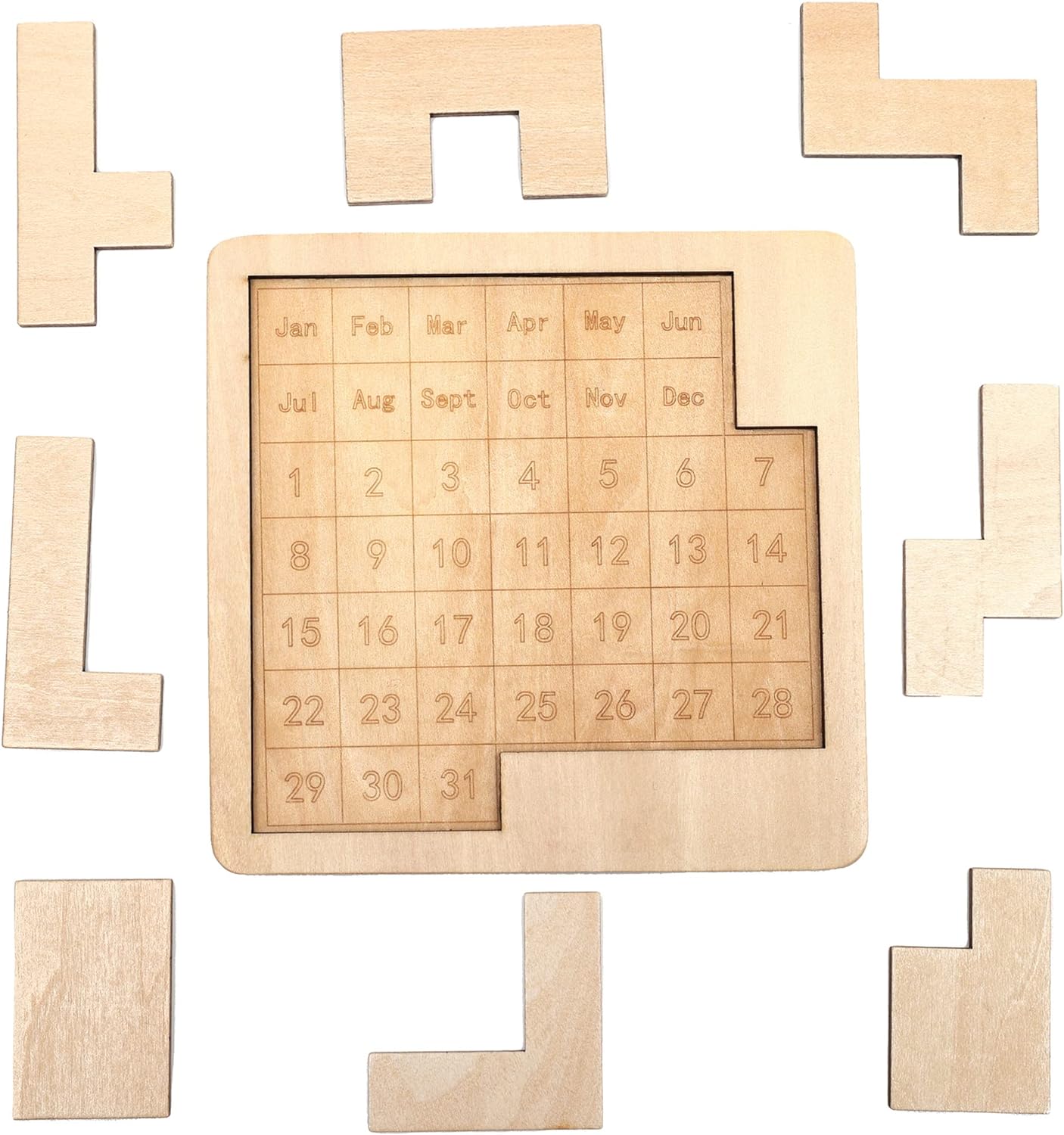
There are multiple possible solutions, e.g. for the month of September.
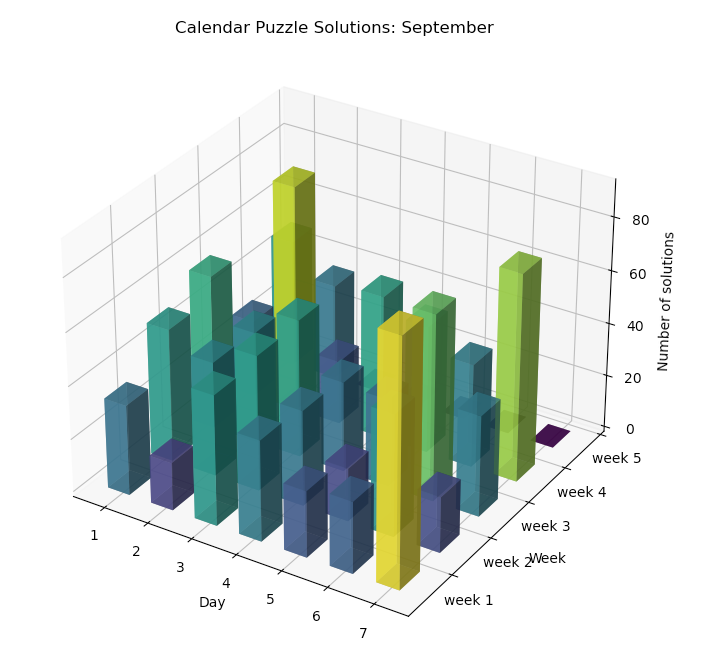
Simple search problem for fitting the 8 pieces.
Apple M1 Max on MacBook Pro 16":
Model Name: MacBook Pro Model Identifier: MacBookPro18,2 Model Number: Z14V001H4J/A Chip: Apple M1 Max Total Number of Cores: 10 (8 performance and 2 efficiency) Memory: 64 GB
Single day parallel:
?- time(solveP(sep,7)).
% 3,994 inferences, 0.007 CPU in 263.628 seconds (0% CPU, 558680 Lips)
true.
?- prBoards(N).
solveP(Mon,Day) :- pieces([P|_]), retractall(soln(_)), board(B), month(Mon,B), day(Day,B), findall(B,place1(P,B),L), copytermL(L,Lp), concurrent_maplist(solve_nf,Lp). %% nf = no-fail %% assume piece 1 has been placed solve_nf(B) :- pieces([_|Ps]), placeL(Ps,B), assertz(soln(B)), fail. solve_nf(_).
All soln/1 are listed by prBoards/1.
Month of September in parallel:

solve(Mon,Day,N) :- % collect all N solutions
pieces(Ps),
board(B),
month(Mon,B),
day(Day,B),
findall(B,placeL(Ps,B),Sols),
length(Sols,N).
Setup:
%% 7 x 7 square with cells blocked off %% Row 0. 1. 2. 3. 4. 5. 6. Col %% 0. months %% 1. months %% 2. 1 2 3 4 5 6 7 %% 3. 8 9 10 11 12 13 14 %% 4. 15 16 17 18 19 20 21 %% 5. 22 23 24 25 26 27 28 %% 6. 29 30 31 board([[_,_,_,_,_,_,0], [_,_,_,_,_,_,0], [_,_,_,_,_,_,_], [_,_,_,_,_,_,_], [_,_,_,_,_,_,_], [_,_,_,_,_,_,_], [_,_,_,0,0,0,0]]). %% board B given Row/Col finds cell Val board(B,Row,Col,Val) :- nth(Row,B,R), nth(Col,R,Val). pieces([1,2,3,4,5,6,7,8]). % 8 piece puzzle
Months on the board:
%% month(Name, Board)
month(jan,[[ja|_]|_]).
month(feb,[[_,fe|_]|_]).
month(mar,[[_,_,mr|_]|_]).
month(apr,[[_,_,_,ap|_]|_]).
month(may,[[_,_,_,_,my|_]|_]).
month(jun,[[_,_,_,_,_,jn|_]|_]).
month(jul,[_,[jl|_]|_]).
month(aug,[_,[_,au|_]|_]).
month(sep,[_,[_,_,se|_]|_]).
month(oct,[_,[_,_,_,oc|_]|_]).
month(nov,[_,[_,_,_,_,no|_]|_]).
month(dec,[_,[_,_,_,_,_,de|_]|_]).
Day on the board:
%% day(Nth, Board)
day(N,B) :-
Row is floor((N - 1) / 7) + 2,
Col is (N - 1) rem 7,
board(B,Row,Col,day(N)).
Let's number the pieces as follows:
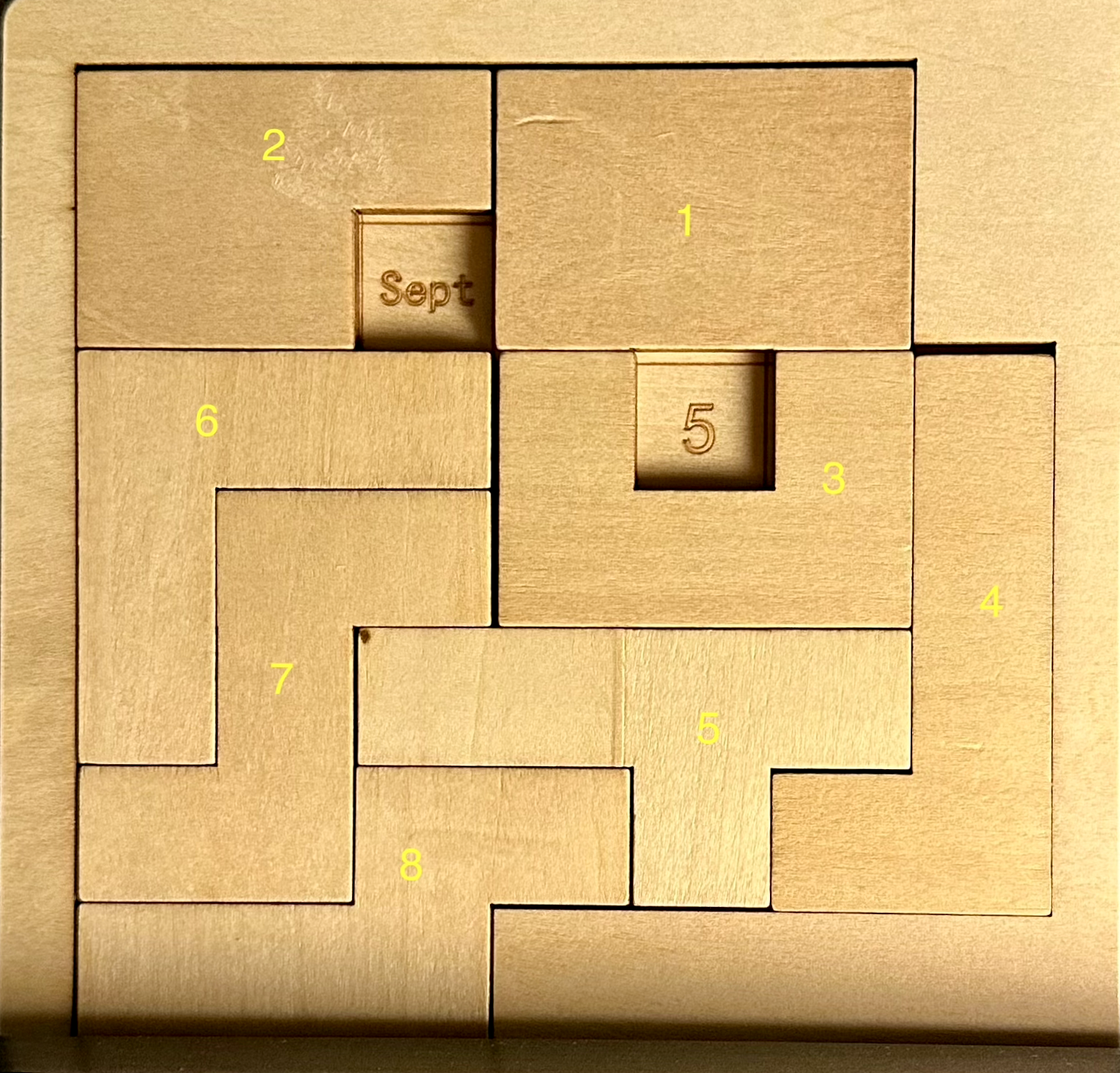
Define each piece and possible orientations:
%%% New representation piece/5 %%% piece(NUM,X,MaxX,MaxY,List) anchors at (X,Y) top-left %%% 46 shape configurations %%% each sublist shares same Y, Y+1, Y+2 etc. %%% MaxX, MaxY savings: M1 Max 694.612 CPU vs. 1104.669 CPU %%% Intel Core i9 2289.239 CPU %%% full rectangle %%% 1 2 3 XXX %%% 4 5 6 XXX piece(1,X,4,5, [[[X,X+1,X+2],[X,X+1,X+2]] % 3 x 2 ]). %%% full rectangle %%% 1 2 XX %%% 3 4 XX %%% 5 6 XX piece(1,X,5,4, [[[X,X+1],[X,X+1],[X,X+1]] % 2 x 3 ]). %%% rectangle missing a corner (4 orientations) %%% 1 2 3 XXX XX XXX XX %%% 4 5 XX XXX XX XXX piece(2,X,4,5, [[[X,X+1,X+2],[X,X+1]], % 3 x 2 (-6) [[X,X+1],[X,X+1,X+2]], % 3 x 2 (-3) [[X,X+1,X+2],[X+1,X+2]], % 3 x 2 (-4) [[X+1,X+2],[X,X+1,X+2]] % 3 x 2 (-1) ]). %%% rectangle missing a corner (4 orientations) %%% 1 2 X X XX XX %%% 3 4 XX XX XX XX %%% 5 XX XX X X piece(2,X,5,4, [[[X],[X,X+1],[X,X+1]], % 2 x 3 (-2) [[X+1],[X,X+1],[X,X+1]], % 2 x 3 (-1) [[X,X+1],[X,X+1],[X+1]], % 2 x 3 (-5) [[X,X+1],[X,X+1],[X]] % 2 x 3 (-6) ]). %%% U (2 orientations) %%% 1 2 3 X X XXX %%% 4 5 6 XXX X X piece(3,X,4,5, [[[X,X+2],[X,X+1,X+2]], % 3 x 2 (-2) [[X,X+1,X+2],[X,X+2]] % 3 x 2 (-5) ]). %%% U (2 orientations) %%% 1 2 XX XX %%% 3 4 X X %%% 5 6 XX XX piece(3,X,5,4, [[[X,X+1],[X+1],[X,X+1]], % 2 x 3 (-3) [[X,X+1],[X],[X,X+1]] % 2 x 3 (-4) ]). %%% L (4 orientations) %%% 1 2 3 4 XXXX X XXXX X %%% 5 6 7 8 X XXXX X XXXX piece(4,X,3,5, [[[X,X+1,X+2,X+3],[X]], % 4 x 2 (+5) [[X],[X,X+1,X+2,X+3]], % 4 x 2 (+1) [[X,X+1,X+2,X+3],[X+3]], % 4 x 2 (+8) [[X+3],[X,X+1,X+2,X+3]] % 4 x 2 (+4) ]). %%% L (4 orientations) %%% 1 2 XX XX X X %%% 3 4 X X X X %%% 5 6 X X X X %%% 7 8 X X XX XX piece(4,X,5,3, [[[X,X+1],[X],[X],[X]], % 2 x 4 (+2) [[X,X+1],[X+1],[X+1],[X+1]], % 2 x 4 (+1) [[X],[X],[X],[X,X+1]], % 2 x 4 (+8) [[X+1],[X+1],[X+1],[X,X+1]] % 2 x 4 (+7) ]). %%% T asymmetric (4 orientations) %%% 1 2 3 4 XXXX XXXX X X %%% 5 6 7 8 X X XXXX XXXX piece(5,X,3,5, [[[X,X+1,X+2,X+3],[X+1]], % 2 x 4 (+6) [[X,X+1,X+2,X+3],[X+2]], % 2 x 4 (+7) [[X+1],[X,X+1,X+2,X+3]], % 2 x 4 (+2) [[X+2],[X,X+1,X+2,X+3]] % 2 x 4 (+3) ]). %%% T asymmetric (4 orientations) %%% 1 2 X X X X %%% 3 4 XX X XX X %%% 5 6 X XX X XX %%% 7 8 X X X X piece(5,X,5,3, [[[X],[X,X+1],[X],[X]], % 4 x 2 (+4) [[X],[X],[X,X+1],[X]], % 4 x 2 (+6) [[X+1],[X,X+1],[X+1],[X+1]], % 4 x 2 (+3) [[X+1],[X+1],[X,X+1],[X+1]] % 4 x 2 (+5) ]). %%% L symmetric (4 orientations) %%% 1 2 3 XXX XXX X X %%% 4 5 6 X X X X %%% 7 8 9 X X XXX XXX piece(6,X,4,4, [[[X,X+1,X+2],[X],[X]], % 3 x 3 (top-left) [[X,X+1,X+2],[X+2],[X+2]], % 3 x 3 (top-right) [[X+2],[X+2],[X,X+1,X+2]], % 3 x 3 (bottom-right) [[X],[X],[X,X+1,X+2]] % 3 x 3 (bottom-left) ]). %%% Z %%% 1 2 3 XX X X XX %%% 4 5 6 X XXX XXX X %%% 7 8 9 XX X X XX piece(7,X,4,4, [[[X,X+1],[X+1],[X+1,X+2]], % 3 x 3 Z [[X],[X,X+1,X+2],[X+2]], % 3 x 3 Z 90 [[X+2],[X,X+1,X+2],[X]], % 3 x 3 Z -90 [[X+1,X+2],[X+1],[X,X+1]] % 3 x 3 Z backwards ]). %%% long Z asymmetric (4 orientations) %%% 1 2 3 4 XX XX XXX XXX %%% 5 6 7 8 XXX XXX XX XX piece(8,X,3,5, [[[X+2,X+3],[X,X+1,X+2]], % Z backwards [[X,X+1],[X+1,X+2,X+3]], % Z [[X,X+1,X+2],[X+2,X+3]], % Z backwards mirror(v) [[X+1,X+2,X+3],[X,X+1]] % Z mirror(v) ]). %%% long Z asymmetric (4 orientations) %%% 1 2 X X X X %%% 3 4 XX XX X X %%% 5 6 X X XX XX %%% 7 8 X X X X piece(8,X,5,3, [[[X],[X,X+1],[X+1],[X+1]], % Z 90 [[X+1],[X,X+1],[X],[X]], % Z 90 mirror(v) [[X+1],[X+1],[X,X+1],[X]], % Z -90 [[X],[X],[X,X+1],[X+1]] % Z -90 mirror(v) ]).
Basic method is to place one piece at a time from piece 1 through piece 8:
%% place list of pieces on board B placeL([],_). placeL([P|Ps],B) :- place1(P,B), placeL(Ps,B). %% place piece P on B at (X,Y) valued V place1(P,B) :- enum(B,X,Y,V), place(P,V,X,Y,B). %% place piece P with selected orientation O at (X,Y) onto board B %% HACK: top-left (V) occupied, select shapes with empty top-left only %% if already occupied, fails and re-selects place(P,V,X,Y,B) :- (var(V) -> select(P,X,Y,O) ; select_e(P,X,Y,O)), all_sqs(O,Y,B,P). %% piece N select an orientation O anchored at (X,Y) %% (X,Y) given, check against Mx, My for efficiency select(N,X,Y,O) :- piece(N,X,Mx,My,Os), X =< Mx, Y =< My, member(O,Os). %% Positions: %% [[X coords],[X coords]...] %% row Y row Y+1 %% all_sqs(Positions, Y, Board, P) all_sqs([],_,_,_). all_sqs([R|Rs],Y,B,P) :- nth(Y,B,Row), sqs_row(R,Row,P), Y1 is Y+1, all_sqs(Rs,Y1,B,P). %% X-coord squares on selected Row (Yth) sqs_row([],_,_). sqs_row([X|Xs],Row,P) :- Xp is eval(X), nth(Xp,Row,P), sqs_row(Xs,Row,P). %% N num: select nth(N,[X|L],P) :- N == 0 -> P = X ; M is N-1, nth(M,L,P).
Notes:
Given a board, enum/4, generates (X,Y) with value V at that location for possible X and Y, as long as V is not 0 (off-board).
%% enumerate X and Y, report value V of piece %% HACK: fail when piece valued 0 (end of row, see initial board above) % top-left cannot work,overlaps with MaxX MaxY %%% here rules out slightly earlier enum(B,X,Y,V) :- nth(B,0,Y,Row), nth(Row,0,X,V), V \== 0. %% select Nth item X from list (enumerate) %% call with N = 0 initially nth([X|_],N,N,X). nth([_|L],N,M,X) :- N1 is N+1, nth(L,N1,M,X).
A subset of piece/5 for which the top-left corner (X,Y) is empty.
%% piece_e(P,X,MaxX,MaxY,List) empty top-left only %% Optimization for speed %% 15 shapes configurations only, cf. 46 configurations piece/5 %% P = 1 and 3 omitted, top-left always filled piece_e(2,X,4,5, [[[X+1,X+2],[X,X+1,X+2]] % 3 x 2 (-1) ]). piece_e(2,X,5,4, [[[X+1],[X,X+1],[X,X+1]] % 2 x 3 (-1) ]). piece_e(4,X,3,5, [[[X+3],[X,X+1,X+2,X+3]] % 4 x 2 (+4) ]). piece_e(4,X,5,3, [[[X+1],[X+1],[X+1],[X,X+1]] % 2 x 4 (+7) ]). piece_e(5,X,3,5, [[[X+1],[X,X+1,X+2,X+3]], % 2 x 4 (+2) [[X+2],[X,X+1,X+2,X+3]] % 2 x 4 (+3) ]). piece_e(5,X,5,3, [[[X+1],[X,X+1],[X+1],[X+1]], % 4 x 2 (+3) [[X+1],[X+1],[X,X+1],[X+1]] % 4 x 2 (+5) ]). piece_e(6,X,4,4, [[[X+2],[X+2],[X,X+1,X+2]] % 3 x 3 (bottom-right) ]). piece_e(7,X,4,4, [[[X+2],[X,X+1,X+2],[X]], % 3 x 3 Z -90 [[X+1,X+2],[X+1],[X,X+1]] % 3 x 3 Z backwards ]). piece_e(8,X,3,5, [[[X+2,X+3],[X,X+1,X+2]], % Z backwards [[X+1,X+2,X+3],[X,X+1]] % Z mirror(v) ]). piece_e(8,X,5,3, [[[X+1],[X,X+1],[X],[X]], % Z 90 mirror(v) [[X+1],[X+1],[X,X+1],[X]] % Z -90 ]).
All solutions for September 6th:
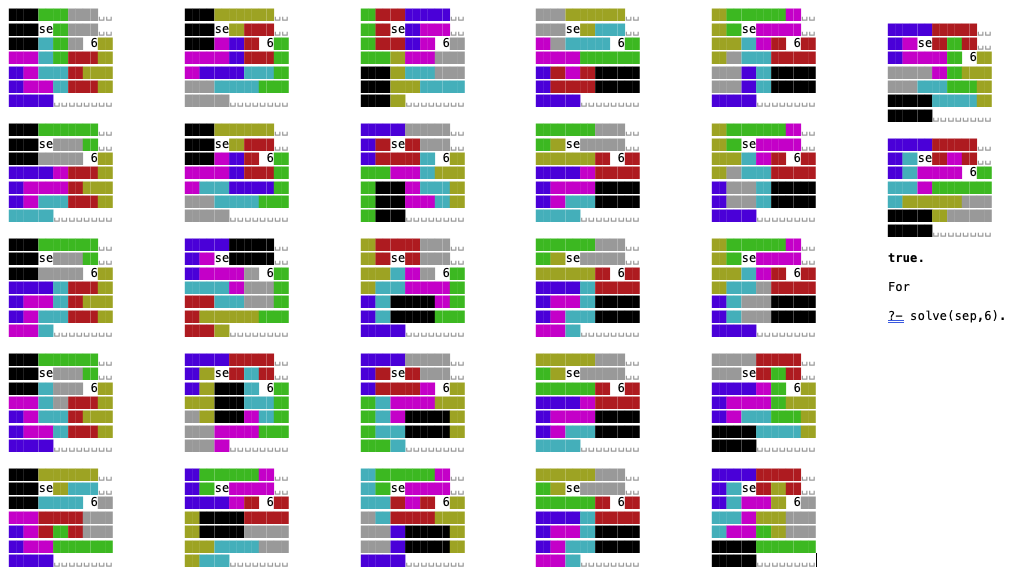
Assume solutions have been recorded in the database as facts soln/1.
prBoards(_) :-
nb_setval(count,0),
soln(B),
nb_getval(count,N),
M is N+1,
nb_setval(count,M),
prBoard(B),
fail.
prBoards(N) :- nb_getval(count,N).
prBoard([]) :- nl.
prBoard([R|Rs]) :- prRow(R), prBoard(Rs).
prRow([]) :- nl.
prRow([X|L]) :- prCell(X), prRow(L).
prCell(X) :-
(var(X) -> write(' ')
; (X == 0 -> ansi_format([fg('#EBDBDB')],'␣␣',[])
; (X = day(N) -> (N > 9 -> format('~d',[N]) ; format(' ~d',[N]))
; (atom(X) -> write(X)
; color(X,C),
ansi_format([fg(C)],'██',[]))))).
color(1,black).
color(2,'#818383').
color(3,red).
color(4,green).
color(5,yellow).
color(6,blue).
color(7,magenta).
color(8,cyan).
Download source: calendar.prolog.zip.